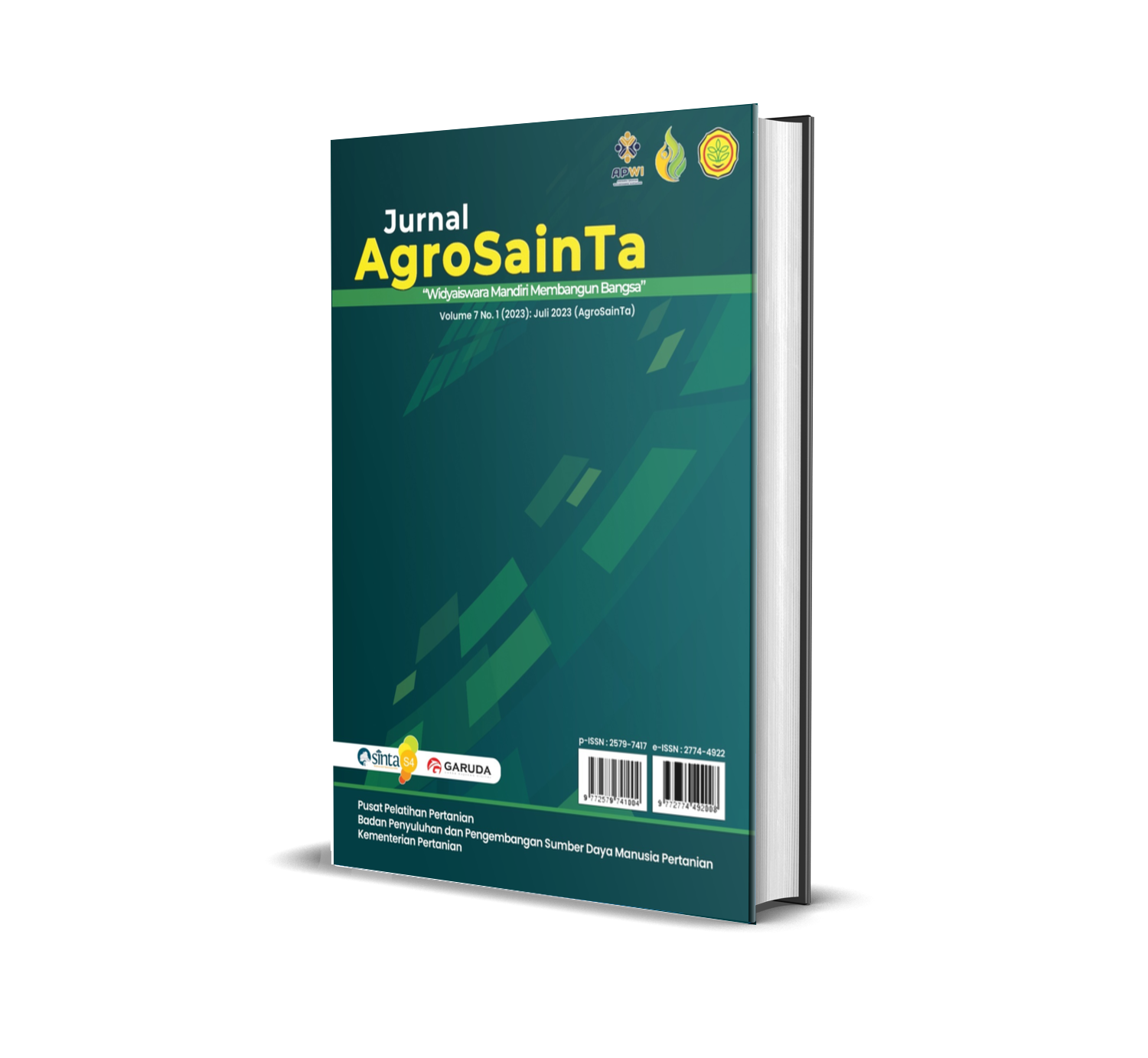The Correlation Between Plasma Phosphor and Cholesterol on Reproduction Performance of Holstein-Friesian Crossbred
DOI:
https://doi.org/10.51589/ags.v7i1.2507Abstract
This study was aimed to identify plasma phosphor and plasma cholesterol and its correlation to reproduction efficiency of Holstein-Friesian Crossbred. The material used in this research was blood sample collected from sixteen heads of cow on second to third lactation in luteal phase. Blood was collected eight hours after feeding time from caudal vein. Reproduction parameters investigated were postpartum breeding; inseminations per conception; and calving interval. Pearson correlation model was used to analyze the data. The average of plasma phosphor and plasma cholesterol concentration were 2.27 ± 0.36 mg/dl and 139.74 ± 25.82 mg/dl respectively. The average of postpartum breeding, calving interval, and inseminations per conception were 133.56 ± 59.34; 410.43 ± 71.01; and 2.00 ± 0.90 respectively. The correlation coefficient of the plasma phosphor on postpartum breeding, inseminations per conception, and calving interval from this study were -0.080; –0.122; and -0.359 respectively. Correlation coefficient of plasma cholesterol on postpartum breeding, inseminations per conception, and calving interval were -0.114; –0.573; and -0.402 respectively. It could be concluded that plasma phosphor correlated negatively to the postpartum breeding and inseminations per conception with the r value of very weak negative correlation while it correlated negatively to the calving interval with the r value of weak negative correlation. The plasma cholesterol had a moderate negative correlation on inseminations per conception and calving interval, and correlated negatively to the postpartum breeding with the r value of very weak negative correlation
References
Amle, M., Patodkar, V., Shelar, R., & Birade, H. (2014). Serum Biochemical Levels of Repeat Breeder Cross Bred Cows under Rural Condition of Satara District of Maharashtra. International Journal of Advanced Veterinary Science and Technology, 3(1), 109–113. https://doi.org/10.23953/cloud.ijavst.193
Barson, R. K., Padder, S., Sayam, A. S. M., Rahman, M. M., Musharraf, M., Bhuiyan, U., & Bhattacharjee, J. (2019). Serum glucose, urea nitrogen, cholesterol, and total proteins in crossbred repeat breeder and normally cyclic cows. Journal of Advanced Veterinary and Animal Research, 6(1), 82–85. https://doi.org/10.5455/javar.2019.f316
Barui, A., Batabyal, S., Ghosh, S., Saha, D., & Chattopadhyay, S. (2015). Plasma mineral profiles and hormonal activities of normal cycling and repeat breeding crossbred cows: A comparative study. Veterinary World, 8(1), 42–45. https://doi.org/10.14202/vetworld.2015.42-45
Bindari, N., Yugal, N., Enyenihi, G. ., Akpabio, U., & Offiong, E. . (2013). Effects of nutrition on reproduction : a Review. Advances in Applied Science Research, 4(1), 421–429.
Bisinotto, R. S., Greco, L. F., Ribeiro, E. S., Martinez, N., Lima, F. S., Staples, C. R., Thatcher, W. W., & Santos, J. E. P. (2012). Influences of nutrition and metabolism on fertility of dairy cows. Anim Reprod, 9(3), 260–272.
Bragança, L. G., & Zangirolamo, A. F. (2018). Strategies for increasing fertility in high productivity dairy herds. Animal Reproduction, 15(3), 256–260. https://doi.org/10.21451/1984-3143-AR2018-0079
Cetin, M., Dogan, I., Polat, U., Yalcin, A., & Turkyilmaz, O. (2002). Blood biochemical parameters in fertile and repeat breeder cows. Indian Journal of Animal Science, 72(10), 865–866.
Ceylan, A., Serin, I., Aksit, H., & Seyrek, K. (2008). Concentrations of some elements in dairy cows with reproductive disorders. Bulletin of the Veterinary Institute in Pulawy, 52(1), 109–112.
Do, C., Wasana, N., Cho, K., Choi, Y., Choi, T., Park, B., & Lee, D. (2013). The effect of age at first calving and calving interval on productive life and lifetime profit in Korean holsteins. Asian-Australasian Journal of Animal Sciences, 26(11), 1511–1517. https://doi.org/10.5713/ajas.2013.13105
Fanani, S., Subagyo, Y. B. P., & Lutojo. (2013). Kinerja reproduksi sapi perah peranakan friesian holstein (PFH) di kecamatan pudak, kabupaten ponorogo. Tropical Animal Husbandry, 2(1), 21–27.
Guzel, S., & Tanriverdi, M. (2014). Comparison of serum leptin, glucose, total cholesterol and total protein levels in fertile and repeat breeder cows. Revista Brasileira de Zootecnia, 43(12), 643–647. https://doi.org/10.1590/S1516-35982014001200003
Khan, M. H., Manoj, K., & Pramod, S. (2016). Reproductive disorders in dairy cattle under semi-intensive system of rearing in North-Eastern India. Veterinary World, 9(5), 512–518. https://doi.org/10.14202/vetworld.2016.512-518
Prihatno, S. ., Kusumawati, A., Karja, N. W. ., & Sumiarto, B. (2013). Blood biochemical profile in repeat breeding dairy cows. Jurnal Kedokteran Hewan, 7(1), 29–31.
Rajesh, P., Sastry, G. ., & Parvathi, G. (2015). Effect of yoga therapy on anthropometry, metabolic parameters and cardiac autonomic function tests in type 2 diabetes mellitus patients. International Journal of Biomedical Research, 6(05), 5. https://doi.org/10.7439/ijbr
Regmi, G., & Dhakal, I. P. (2020). Systemic levels of iron, phosphorus, and total protein in normocyclic versus repeat breeder holstein friesian crossbred cows of kesharbag, Chitwan, Nepal. Veterinary World, 13(11), 2353–2357. https://doi.org/10.14202/VETWORLD.2020.2353-2357
Riyanto, J., Lutojo, L., & Barcelona, D. M. (2017). Kinerja Reproduksi Induk Sapi Potong pada Usaha Peternakan Rakyat di Kecamatan Mojogedang. Sains Peternakan, 14(1), 73. https://doi.org/10.20961/sainspet.v13i2.11478
Santoso, S. (2006). Statistik Parametrik. Elex Media Komputindo.
Silbernagl, S., & Despopoulus, A. (2009). Color Atlas of Physiology. Color Atlas of Physiology.
Wettemann, R., Lents, C., Ciccioli, N. ., White, F. ., & Rubio, I. (2003). Nutritional and Suckling Mediated Anovulation In Beef Cows. Journal of Animal Science, 81.
Widayati, D. T. (2017). Blood Biochemical Profile of Repeated Breeding Friesian Holstein Grade Cows in The Dairy Processing Unit Faculty of Animal Science Gadjah Mada University. International Seminar on Tropical Animal Production …, 743–747. https://journal.ugm.ac.id/istapproceeding/article/view/29919
Widayati, D. T., Bintara, S., Natawihardja, I., & Maharani, D. (2018). Blood biochemical profile in fertile and repeat breeder ongole cross breed cows. Pakistan Journal of Biological Sciences, 21(4), 166–170. https://doi.org/10.3923/pjbs.2018.166.170
Widayati, D. T., Paramita, M. A., Dwiviyanti, E., & Suranindyah, Y. (2019). Correlation Between Blood Metabolite and Reproductive Performance of Lactating Holstein Friesian Crossbred Cows in Smallholder Farmers. Jurnal Kedokteran …, 13(March), 1–4. https://core.ac.uk/download/pdf/291478252.pdf
Widayati, D. T., Sunendar, Suharto, K., Asuti, P., & Junaidi, A. (2011). The effect of body condition score on hormonal and vaginal histological changes during estrus of synchronized etawah cross bred does. World Academy of Science, Engineering and Technology, 77(June), 408–410.
Downloads
Published
Issue
Section
License
Copyright (c) 2023 Muhammad Arif Darmawan, Diah Tri Widayati , Yustina Yuni Suranindyah

This work is licensed under a Creative Commons Attribution 4.0 International License.









